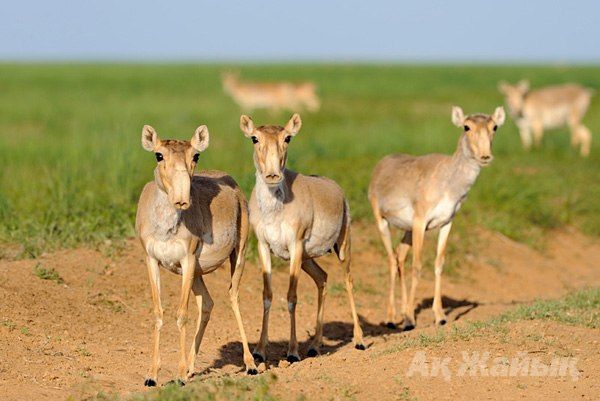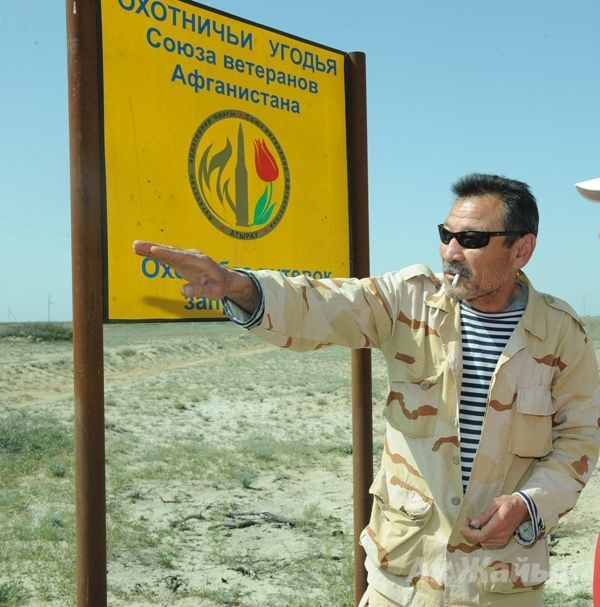By Murat Sultangaliyev
 Saktapbergen Alipkayyirov, a deputy head of territorial forestry and hunting inspection, says the last time his officers saw saiga tatarica within the borders of Atyrau oblast was October 2012, near the village of Azgir. It was a rare view of the Volga-Ural species, a one-time numerous type of animals [28,000 heads].
Saktapbergen Alipkayyirov, a deputy head of territorial forestry and hunting inspection, says the last time his officers saw saiga tatarica within the borders of Atyrau oblast was October 2012, near the village of Azgir. It was a rare view of the Volga-Ural species, a one-time numerous type of animals [28,000 heads].
In 2011, 12,000 saigas fell victim to a pasteurellosis epidemic. Another 400 died in the West Kazakhstan Oblast from an unknown cause. No records have been made about encountering Ustyurt population in the recent years. Kazakhstan laws restrict withdrawal of saiga from their life environment until 2020.
Lands of the provincial Association of 1979-89 Afghan War Veterans are a home to nearly 70 antelopes.
Chairman Assyltek Ispussinov says:
“It began with us having read an article in archives that in ‘80s people started to breed pheasants in the oblast. In 1992 we brought some 100 birds from Russia and set them free in our lands. But they disappeared. Then our Russian colleagues advised us to plant thorn bushes and wild herbs, so the pheasants could hide from predators. That’s what we did – every year we used to plant several hectares with salt trees, heather and wild oat. Another 1,000 pheasants were brought from Russia’s Rostov Oblast and a pair of cocks from Volgograd. Now our pheasants have spread over tens of kilometers along the sea coast.”
They ride camels to count pheasants. Once a bird hears a car coming it flies away, but on a camel and with a binocular in hands one may see them clearly enough. The same method is used to keep count of antelopes.
 “Our foresters are local men from Issatai District. They hate poachers exterminating our unique herd of saiga. Upon a call, my “Afghan guys” quickly arrive and literally break poachers’ guns against their own heads,” Ispussinov says.
“Our foresters are local men from Issatai District. They hate poachers exterminating our unique herd of saiga. Upon a call, my “Afghan guys” quickly arrive and literally break poachers’ guns against their own heads,” Ispussinov says.
Winters of 1993-1995 were freezing and snowy. ‘Afghans’ used to clean snow with tractors and brought hay for the lovely “pets”. Ever since, saiga permanently lives here. Now we have 50 females and nearly 20 males.
Faizulla, a forester, says his responsibilities include protection of the area not only from poachers, but from wolves as well. The grey bandits are killed with guns and traps. Unlike in folklore tales, a wolf is much smarter than a fox. It will never rush to a carcass, but will wait until foxes and jackals start eating first to soon chase them away and get the whole prey. That’s why traps mostly catch foxes.
We persuaded Assyltek to take us to the hunting area and show us his nurslings. We happened there in a lambing period.
“For giving birth and until the lambs get stronger, females split off herd and hide. Over that period they are very fearful and careful,” says Assyltek giving me a binocular. In some two kilometers I saw a yellow spot, which suddenly moved and quickly vanished in bushes.
“That’s not a ghost, but a living saiga, smiled Assyltek. – It likes this place and we decided to make it happier – we bought Canada rice seeds in St. Petersburg and now going to plant them.”
 В Атырау -1
В Атырау -1